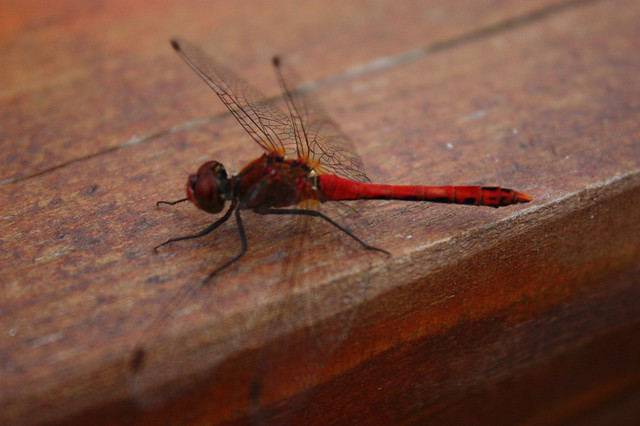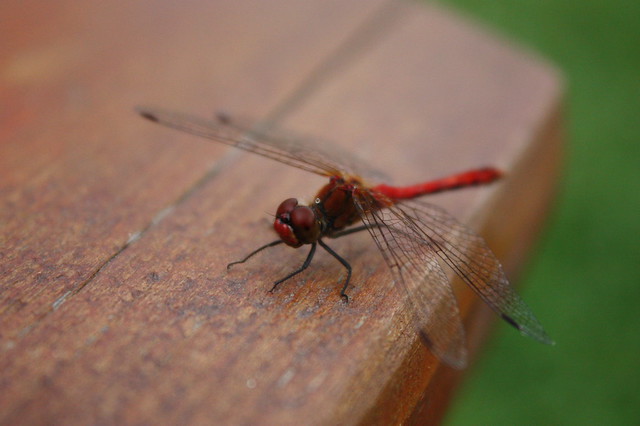Back, One:
Download original.
Download original.
Side, Two:
Download original.
Okay, first, an error on my part: I originally identified this as the Sympetrum fonscolombii, or Red-veined Darter. Unfortunately, I was too zealous with that classification. While S. fonscolombii has yellow-striped legs, eyes with a blue/grey underside, lack of waist, and pale pterostigma, this specimen has none of those things. How could I confuse it for a Red-veined Darter! (Yes, it's not even a question.)
So, what species, then, is it? I believe it is the Ruddy Darter (Sympetrum sanguineum). The British Dragonfly Society says this about S. sanguineum:
Intense orange colouration at base of wings: check.
Brown pterostigma: check.
Two prominent black marks on S8 and S9: check.
Noticeable constriction of the abdomen (i.e. waist) around S4: check.
Now, we do need to base classifications on more than appearance, things like behaviour, habitat, and diet, but as we can't do any of those things (minus habitat, which is also confirmed), my tentative conclusion is that this specimen is indeed the Ruddy Darter, S. sanguineum. I want to add, however, that, as always, I'm not a taxonomist or entomologist. If you are and think I got this wrong, please point me in the correct direction.
Both S. fonscolombii and S. sanguineum are commonly found in their range and doing well, according to the IUCN Red List (source here and here), and while for S. sanguineum that includes northwestern Europe, S. fonscolombii has only started encroaching on that area recently. According to Habitas, it was seen in Ireland (specifically in Cavan) as early as the 1940's, but only started being seen annually in Britain in 1995.
Sources:
http://www.british-dragonflies.org.uk/species/red-veined-darter
http://www.british-dragonflies.org.uk/species/ruddy-darter
http://www.iucnredlist.org/apps/redlist/details/60038/0
http://www.iucnredlist.org/apps/redlist/details/158691/0
http://www.habitas.org.uk/dragonflyireland/5647.htm
http://www.habitas.org.uk/dragonflyireland/5650.htm
http://www.odesforbeginners.com/ID101/dragon_abdomen.aspx
So, what species, then, is it? I believe it is the Ruddy Darter (Sympetrum sanguineum). The British Dragonfly Society says this about S. sanguineum:
This species is smaller than the Common Darter. The legs are entirely black. An intense orange colouration can be seen only at the very base of the wings. The pterostigma is brown. There are usually two prominent black marks on S8 and S9.
The males become blood-red with maturity with a red frons and red-brown thorax. There is a very noticeable constriction of the abdomen around S4, giving a club-shaped appearence.Black legs: check.
Intense orange colouration at base of wings: check.
Brown pterostigma: check.
Two prominent black marks on S8 and S9: check.
Noticeable constriction of the abdomen (i.e. waist) around S4: check.
Now, we do need to base classifications on more than appearance, things like behaviour, habitat, and diet, but as we can't do any of those things (minus habitat, which is also confirmed), my tentative conclusion is that this specimen is indeed the Ruddy Darter, S. sanguineum. I want to add, however, that, as always, I'm not a taxonomist or entomologist. If you are and think I got this wrong, please point me in the correct direction.
Both S. fonscolombii and S. sanguineum are commonly found in their range and doing well, according to the IUCN Red List (source here and here), and while for S. sanguineum that includes northwestern Europe, S. fonscolombii has only started encroaching on that area recently. According to Habitas, it was seen in Ireland (specifically in Cavan) as early as the 1940's, but only started being seen annually in Britain in 1995.
Sources:
http://www.british-dragonflies.org.uk/species/red-veined-darter
http://www.british-dragonflies.org.uk/species/ruddy-darter
http://www.iucnredlist.org/apps/redlist/details/60038/0
http://www.iucnredlist.org/apps/redlist/details/158691/0
http://www.habitas.org.uk/dragonflyireland/5647.htm
http://www.habitas.org.uk/dragonflyireland/5650.htm
http://www.odesforbeginners.com/ID101/dragon_abdomen.aspx





No comments:
Post a Comment